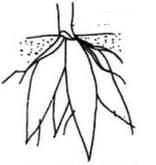MEDIUM
Earn 100
Consider the following statements and choose the correct option.
I. The genetic constitution of a plant is unaffected in vegetative propagation.
II. Rhizome in ginger serves as an organ of vegetative reproduction.
III. Totipotency of cells enables us to micropropagate plants.
I. The genetic constitution of a plant is unaffected in vegetative propagation.
II. Rhizome in ginger serves as an organ of vegetative reproduction.
III. Totipotency of cells enables us to micropropagate plants.
(a)Statements I and II alone are true
(b)Statements II and III alone are true
(c)Statements II alone is true
(d)All the three Statements I, II and II are true
50% studentsanswered this correctly
Important Questions on Reproduction in Organisms
EASY
EASY
MEDIUM
EASY
MEDIUM
EASY
EASY
MEDIUM
MEDIUM
Which option shows correctly matched pairs for Column I and Column II?
| Column I | Column II | ||
| P) | Planaria | i) | Fragmentation |
| Q) | Sycon | ii) | Fission |
| R) | Star-fish | iii) | Spore formation |
| S) | Plasmodium | iv) | Budding |
EASY
What is artificial method of vegetative propagation?
Cutting
MEDIUM
In the given diagram, which organ shows vegetative reproduction?
EASY
MEDIUM
EASY
Mention the vegetative propagules of the following plants :
Water Hyacinth
EASY
Mention the vegetative propagules of the following plant :
Agave
MEDIUM
EASY
What is artificial method of vegetative propagation?
Budding
MEDIUM
Lateral branches arise from the basal and underground part of the main stem
Branches bent and grow downwards
Branches grow obliquely upwards
Lateral branches arise from the base of the main axis and are aerial


